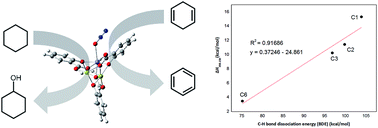The enzyme-like catalytic hydrogen abstraction reaction mechanisms of cyclic hydrocarbons with magnesium-diluted Fe-MOF-74†
Abstract
Enzymatic heme and non-heme Fe(IV)–O species usually play an important role in hydrogen abstraction of biocatalytic reactions, yet duplicating the reactivity in biomimicry remains a great challenge. Based on Xiao et al.'s experimental work [Nat. Chem., 2014, 6(7), 590], we theoretically found that in the presence of the oxidant N2O, the enzyme-like metal organic framework, i.e., magnesium-diluted Fe-MOF-74 [Fe/(Mg)-MOF-74] can activate the C–H bonds of 1,4-cyclohexadiene (CHD) into benzene with a two-step hydrogen abstraction mechanism based on the density functional theory (DFT) level. It is shown that the first transition state about the cleavage of the N–O bond of N2O to form the Fe(IV)–O species is the rate-determining step with activation enthalpy of 19.4 kcal mol−1 and the complete reaction is exothermic by 62.8 kcal mol−1 on quintet rather than on triplet PES. In addition, we proposed a rebound mechanism of cyclic cyclohexane (CHA) hydroxylation to cyclohexanol which has not been studied experimentally. Note that the activation enthalpies on the first hydrogen abstraction for both cyclic CHD and cyclohexane are just 8.1 and 3.5 kcal mol−1, respectively, which are less than that of 13.9 kcal mol−1 for chained ethane. Most importantly, for the hydrogen abstraction of methane catalyzed by M/(Mg)-MOF-74 (M = Cu, Ni, Fe, and Co), we found that the activation enthalpies versus the C–H bond length of methane of TSs, NPA charge of the reacting oxyl atom have linear relationships with different slopes, i.e., shorter C–H bond and less absolute value of NPA charge of oxyl atom are associated with lower activation enthalpy; while for the activation of methane, ethane, propane and CHD catalyzed by Fe/(Mg)-MOF-74, there also exists positive correlations between activation enthalpies, bond dissociation energies (BDEs) and C–H bond lengths in TSs, respectively. We hope the present theoretical study may provide the guideline to predict the performance of MOFs in C–H bond activation reactions.



 Please wait while we load your content...
Please wait while we load your content...